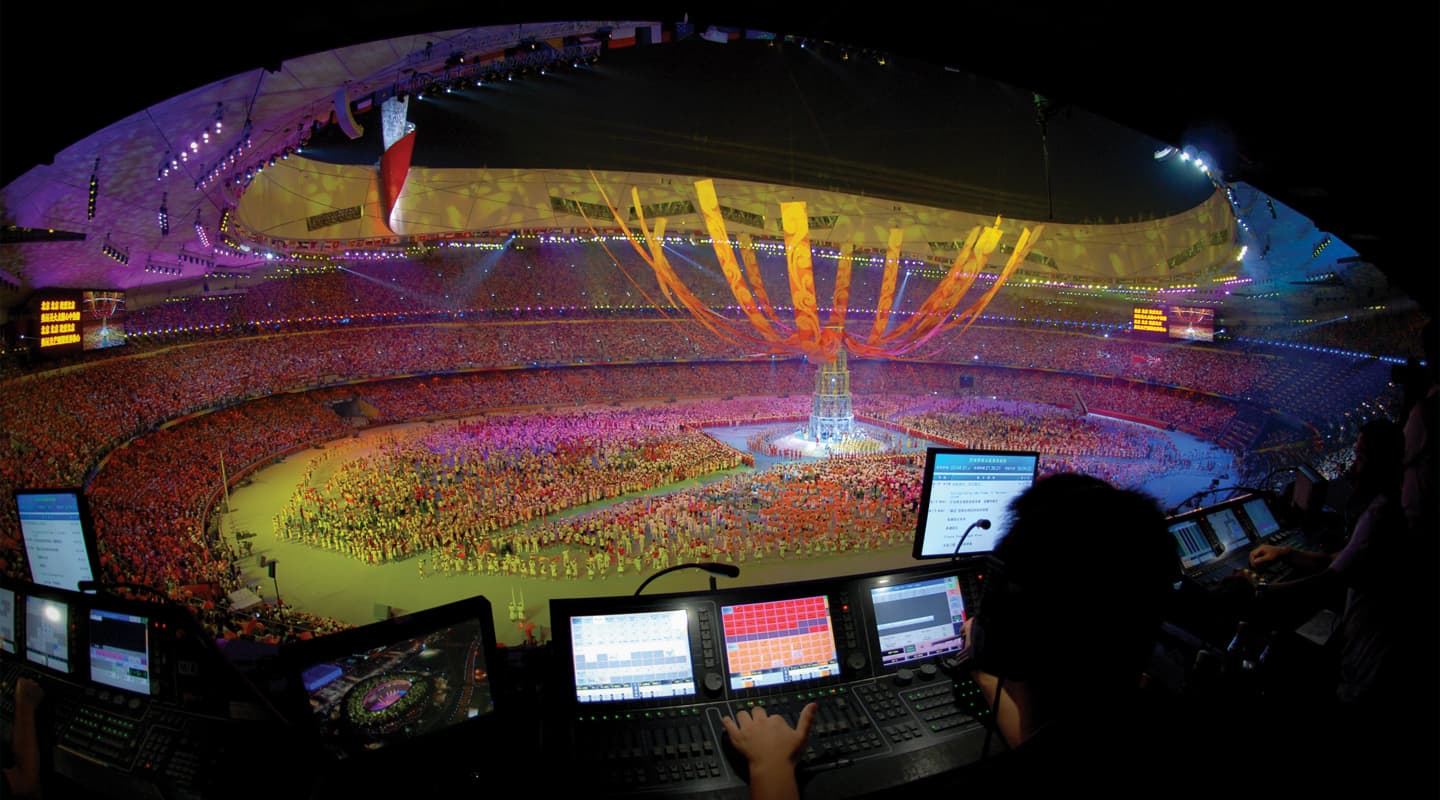
Olympic Lighting Control
Controlling the biggest live gig in the world on just three grandMAs?
Text & images:/ Paul Collison
Control System & Broadcast Lighting Consultant to BOCOG ceremonies
Congratulations! You’ve just been given the honour of illuminating the biggest show in the world. This show will be viewed by billions of people around the globe. You get to choose between all sorts of different lights and other toys to play with for months on end. You can choose fixtures from different manufacturers that have different attributes and cover many jobs in an array of styles.
But what do you use to control your lighting system? This is the question that Mr Sha Xioa Lan had to answer after his appointment as Lighting Designer for the Opening and Closing Ceremonies of the XXIX Olympic Games in Beijing.
It would be safe to say that the control system is the lynch pin in the success of a production. Lights breakdown: that is a fact of life. We expect this and, if we’re wise, we prepare for it. However a control system simply must not fail. Of course, we run back-up consoles and try to account for different variables, but the fact is, a ‘tracking back-up’ console is an integral part of the modern day control system. Otherwise, it’s really not a system.
There are a plethora of questions to ask, and decisions to be made when selecting a control system for such a large-scale event. What products have been tried and tested? What are the back-up capabilities within the proposed control system? How does the system distribute and process information? What kind of back-up service should you expect from the manufacturer? How many people in the country actually know how to use the proposed system? Then there is the inevitable: how much does it cost?
With the distances that needed to be covered for this event, signal latency was something that needed to be considered from the outset. Data had to arrive at every lighting fixture in the system at exactly the same time. Immediately, any system that relies solely on ArtNet to distribute its signal was discounted. ArtNet is a fantastic interim protocol while we wait for a true successor to DMX, however its major failing is that it is a centralised, broadcast protocol. Broadcasting ArtNet from a centralised source to such a widely spread rig was not the answer.
GRANDMA – THE ONLY GAME IN TOWN
This left only a few possible options in the current market, and of these, MA lighting’s grandMA was the only real contender. The grandMA system decentralises its processing of information across every device in the network which ensures frame-accurate output of DMX across the entire system. This means a snap to black will not look staggered throughout the stadium while different devices across the network receive and process information. To facilitate this, MA has developed its own networking protocol called MA Net.
The MA control system was officially selected in January 2008. Although there was plenty of experience in China with using the MA system, there was not a comfortable amount of expertise in the networking side of large-scale outdoor events. I was approached to join the team in December 2007 because my previous experience on large-scale public events and thorough knowledge of the MA system made me an ideal addition to an already experienced team.
Patching a system of this scale is no mean feat. Once all the lighting fixtures are chosen and located on a drawing, the task of allocating fixture IDs (the numbers in which we identify lights, not the DMX address) and allocating DMX streams and addresses begins. Simply numbering the fixtures 1 through to 2500 or so is not an intuitive way to do things. Using the model numbers of the lamps as a reference can help everyone on the team to identify fixtures easily without the need to dive for the nearest folder or lighting plan. In our system, the Clay Paky Alpha 1200s were IDs 1201 thru 1312. Mac 2000 washes started at 2001. VL3000s started at 3001.
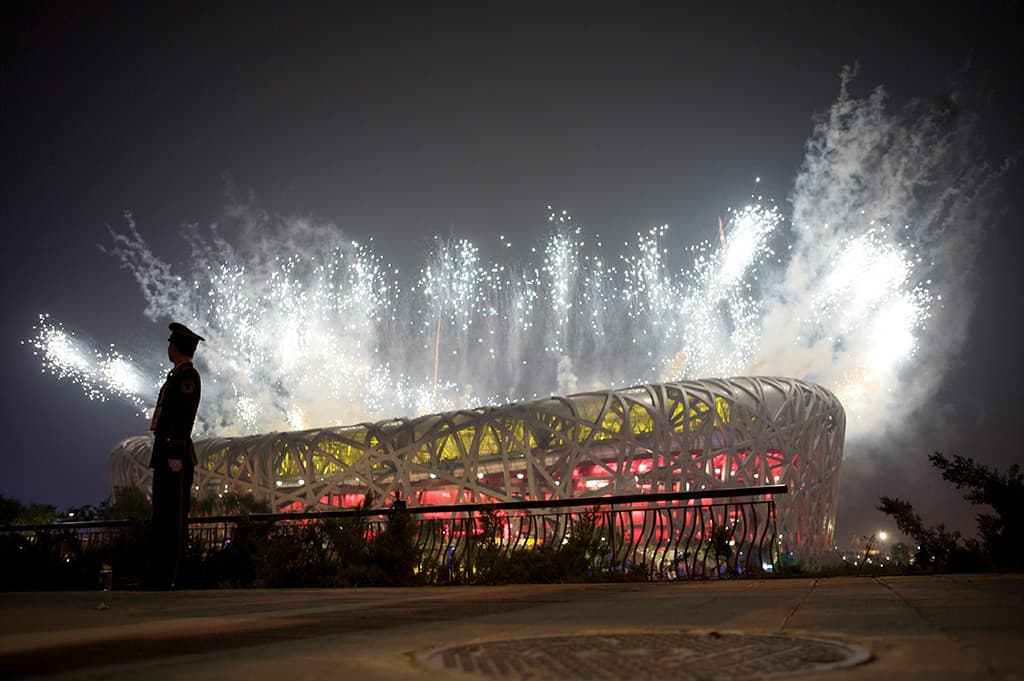
JUST HOW MANY COOKS DO YOU NEED?
When the time came to allocate the fixtures across consoles, the initial thought was to have 10 operators. However, the lighting designer can only work properly with one operator at a time, and sometimes only one operator can ‘have the floor’ to do his/her thing. After considering this, it was decided that less was more. As each operator on a grandMA network can run up to a maximum of 16,384 parameters in their own session, and the entire lighting system was to consist of slightly fewer than 47,000 parameters, we needed a minimum of three operators. Although the configuration virtually filled each session, after careful discussion and analysis it was decided that running with three operators would be the best way to go.
After careful consideration, the final breakdown of which fixtures to allocate to each session, had all of the Mac 2000 washes in the roof in the first session. The second session had every other wash light in the rig, while the third session contained all of the profile fixtures.
Allocation of the network termination points needed to be considered before we could properly allocate DMX streams and addresses. Ultimately 14 locations around the stadium were selected: six in the roof, two on the level-three balcony, three on the level-two balcony, two on the field of play and one in the central pit.
When it came to allocating DMX addresses, many factors needed to be considered. Minimising cable runs was a major issue. Jumping DMX streams between trusses was a definite no-no. Standardisation is something that makes things easy, so keeping a pattern or a flow to things to enable quick and efficient fault finding was also a major consideration. With four people working on it, the DMX allocation process took almost three days. This included allocating DMX addresses, updating the lighting plans and giving every fixture a location in the 3D world to utilise the wireframe visualiser and grandMA 3D.
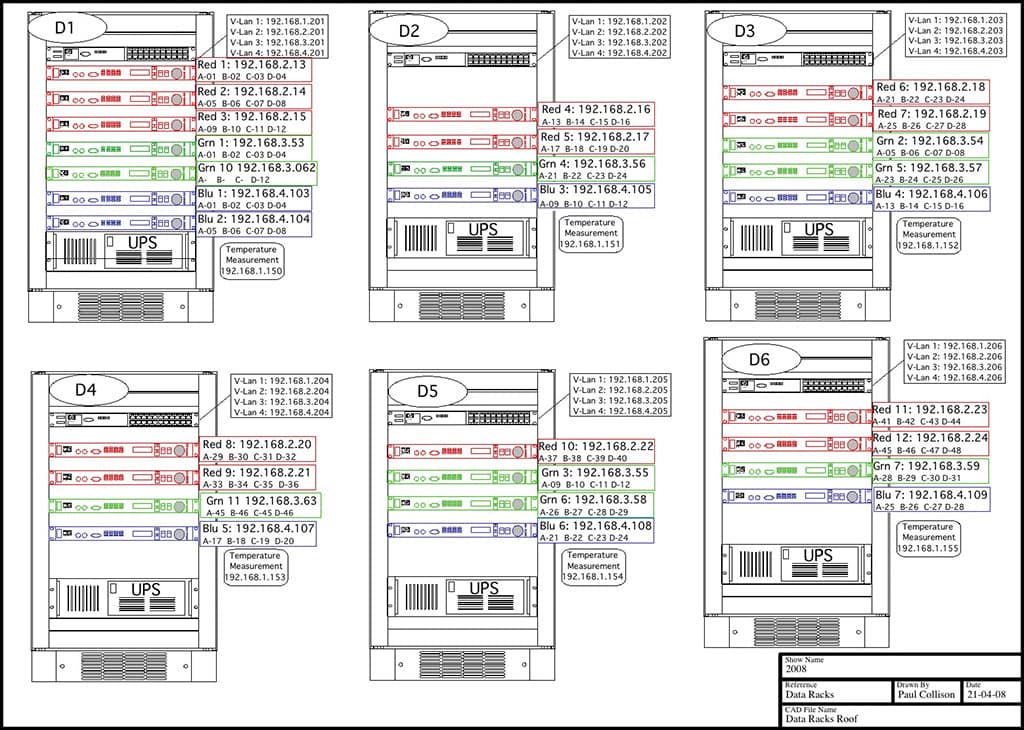
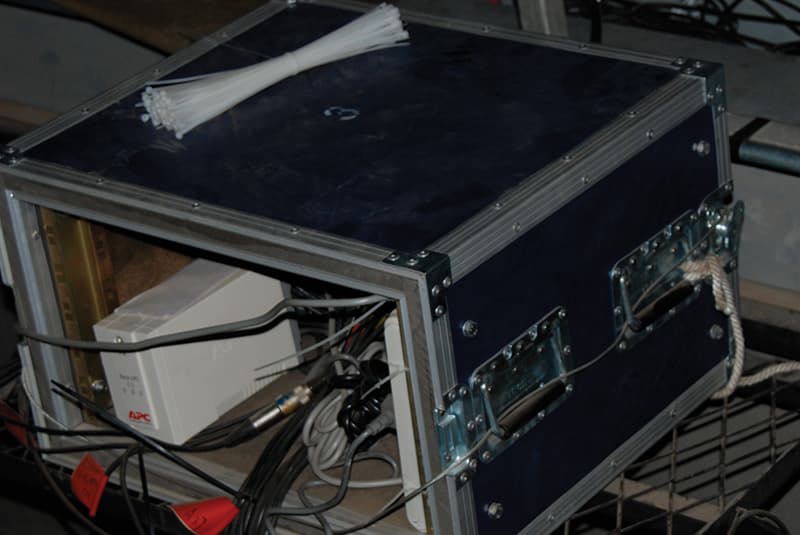
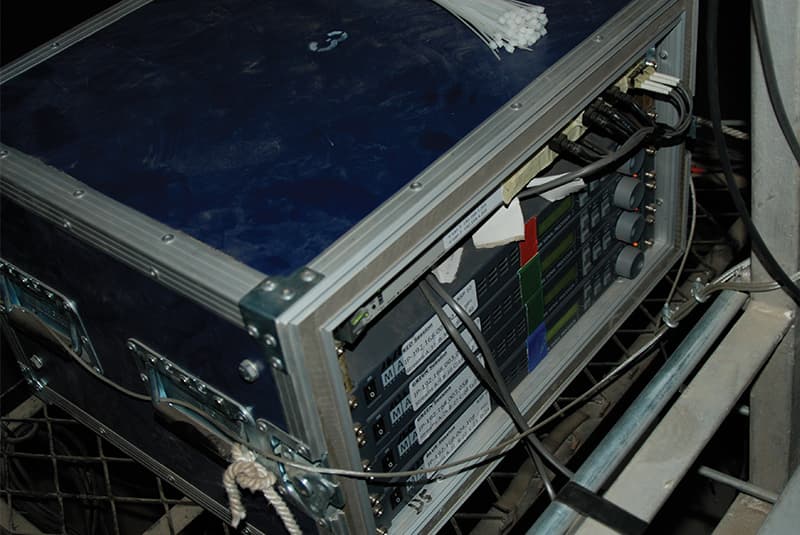
AND NOW FOR THE NETWORK NEWS…
At this point in the project, all the plans were handed to the production companies responsible for installing the lighting fixtures. Planning on the control side then moved over to the specifications for the fibre optic network. In the original design, a Cisco network with passive data flow, redundant power supplies, networkable UPSs and environmental monitoring was specified. This system had the advantage of being able to pass data passively, so that if there was a power outage in a particular location, the information flow around the network would not be compromised. Other benefits of that network included better redundancy options for power and superior local knowledge and training. Ultimately, due to budget constraints and equipment availability, a less sophisticated, and slightly less fault-tolerant, solution using HP networking gear was agreed upon, and installation began in April 2008.
Optical fibre can be a tricky medium to use. On projects such as this, a military or tactical-grade fibre would be preferred, as the ruggedness of this type of fibre would prove resilient to most of the rough treatment you would expect cable to receive over months in a temporary installation. Once again, for budgetary reasons, a much more brittle, install-grade, single-mode fibre was chosen. This meant that everywhere the fibre was exposed to the possibility of wear and tear or human interaction; a protective conduit had to be put in place. This was quite a labour intensive solution, but acceptable nonetheless. In mid May, 10 weeks before the first ceremony, this fibre backbone in the stadium was brought online.
Following this, the lighting system was gradually brought online and tested. A seamless handover took place on June 14, around eight weeks before the opening ceremony. This now put the design team and programmers in the hot seat and the network monitoring and systems people in a holding pattern waiting for issues and problems to solve.
GETTING DOWN TO PROGRAMMING
During this period everyone settles in to a daily pattern. Mid to late afternoon is when the first wave of crew arrive at the stadium to power up the system. They check for faults and test each and every lighting fixture. The programmers and designers arrive in not long after, and shortly after that programming begins. Each night there are segment rehearsals where cues are rehearsed and different looks are tried. Some nights we placed consoles at various locations around the stadium so as to give the programmers and designers a different view of the stadium. Depending on the flow of the creative juices, programming could continue until sun-up (around 4.30am) or could finish as early as 1 or 2am. This was pretty much the routine right up until the opening ceremony.
The programming style of the Chinese operators was a little different to what we would normally expect for a show of this scale. SMPTE timecode was abandoned at the request of creative director Zhang Ymo. His belief was that the performers were not timecoded so therefore the lighting cues needed to be variable to account for this. Although other departments used the available SMPTE timecode to trigger cues, in the lighting department every cue was manually executed.
The other point of difference was the fact the operators placed each cue on a separate fader rather than in long sequences. A seasoned operator will tell you that a sequence is the best way to lay out a cue-to-cue show to have better control of the fixtures and a better understanding of how the show is laid out. However, this was not the way it was to be done in Beijing. The result was that each recorded cue contained the information for every attribute for over 800 moving lights per session. This ultimately lead to large show files, but despite this, the system was remarkably stable and network integrity was not an issue.
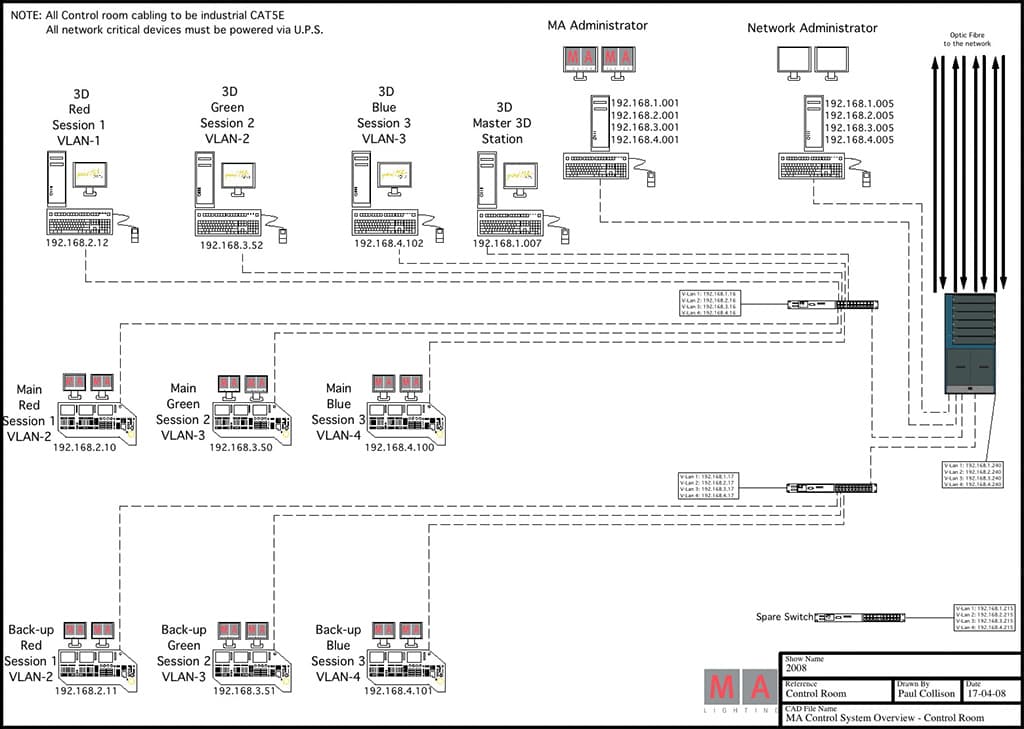
BUT WILL IT REALLY FLY?
Counting down to the opening ceremony, tensions were high. This was China’s big moment to shine. For months or even years, the eyes of the world had been on China, and more specifically Beijing, to see what they could come up with. After spending months looking at the same show and rehearsing with an almost monotonous regularity, it’s easy to lose perspective and not see just how special or amazing the final product is.
There was definitely an air of trepidation going in to the show. Afterwards the sense of relief was amazing, but the scale of the success didn’t sink in for a day or so. Not until glowing media reports came in and internet forums were abuzz with excitement. Only then did the team really begin to truly understand just how well all their hard work had been received.
Of course, it’s totally normal on an event like this that a day or so after the big Opening Ceremony that everyone realises that there is a closing to be done. It’s never surprising that the closing ceremony is treated as the poor cousin to the opening. With the turnaround to athletics in the stadium, and then the actual athletics events, there is very little time to prepare for the closing ceremony. Consequently the design and programming team went into the closing with very few programmed cues.
It’s scary to imagine how someone busks a show with a few thousand lights. However, this is exactly how the closing ceremony went. As in the opening ceremony, the show went as expected (or more precisely: as hoped). This time the sense of relief was far greater as by now the team could safely say that they had successfully pulled off two of the biggest shows the world had ever seen.
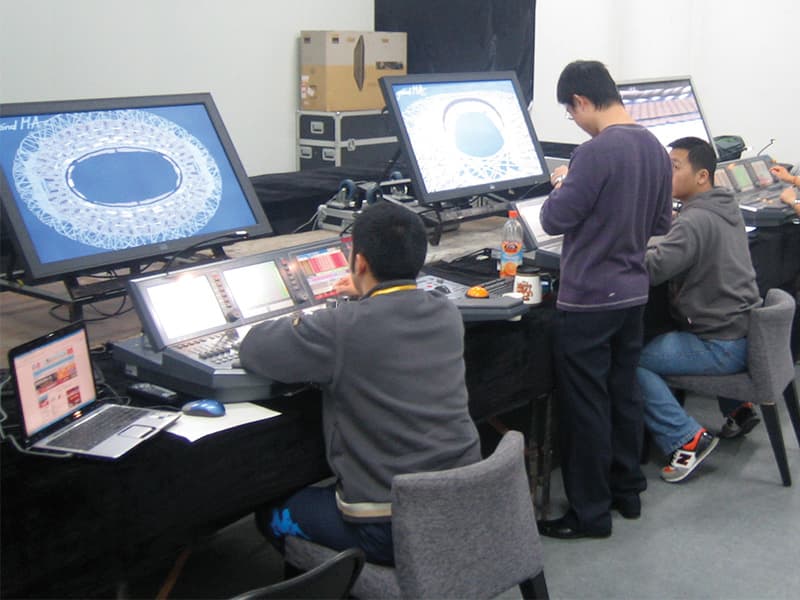
RISING EAST
Despite any outside questions about their ability to handle the Olympics ceremonies, China is no stranger to large-scale theatrical events. The Opening Ceremony of the 2008 World Table Tennis Championship in China was as large as any Eurovision song contest you would care to see and probably seen by as many viewers. This was reflected in the amount of ‘western’ or foreign help there was for these games. Early on in the project there were countless names thrown about. Spielberg was one, Robert Dickenson another, and there were plenty more. These masters of their crafts were certainly heavily involved early on. Ultimately, the Chinese realised this was a show they could produce themselves; both technically and creatively. In the end, there were only a dozen or so foreign crew in the entire ceremonies team. Compare this to the hundreds in Athens and dozens and dozens in Sydney.
The overseas talent brought to Beijing were mainly there as a backstop to the competent locals. On top of the already spectacular show, the most amazing part was that this was a true Chinese production. So when you think back on the Opening and Closing Ceremonies of the 2008 Olympic Games, remember that this show gave a true representation of what China has to offer.
LIGHTING CONTROL
3 x grandMA full size
3 x grandMA full size as backups
2 x grandMA light as remote surfaces for focusing
44 x MA Network Signal Processors (NSP)
Session 1 (Red): 15921 Parameters. 834 Fixtures on 14 x NSP
Session 2 (Green): 13503 Parameters, 884 Fixtures on 16 x NSP
Session 3 (Blue): 15987 Parameters, 624 Fixtures on16 x NSP
3D VISUALISATION
Software – E.S.P Vision & MA3D
Hardware – MA Media PC. NVidia GeForce 8800GTX
MA VIDEO SYSTEM
Three Graphic input cards to overlay the displays from each session in to one.
NETWORK
HP Pro-Curve 2626 Field Switches
Main Switch HP Pro-Curve 8212zl
Kilometers of Multi Mode Fiber
LUMINAIRES
112 x Clay Paky Alpha Wash
980 x Martin Mac 2000 Wash
162 x Martin Mac 2000 XB Wash
308 x Vari*Lite 3500 Spot
316 x Vari*Lite 3000 Spot
180 x Vari*Lite 3500 Wash
12 x High End Show Gun
20 x Ushio 2k Xenon Follow Spot
16 x Kupo Super Sol 3k Xenon Follow Spot
8 x Robert Juliat Lancelot 4kw HTI follow spot
8 x Robert Juliat Cyrano 2.5kW HMI follow spot
204 x PureLight City Color
80 x FineArt Fine2000 Wash
32 x FineArt LED Par Can
46 x Sliver Star LED bank



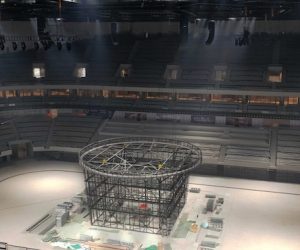


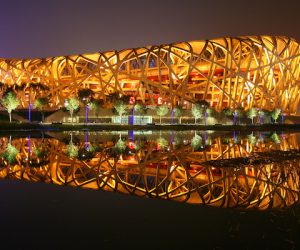
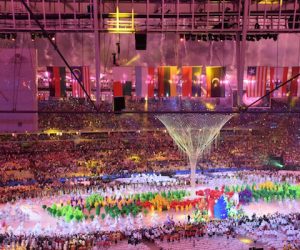
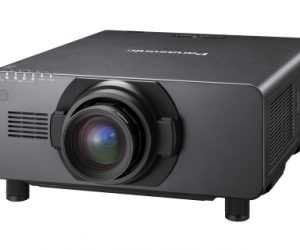

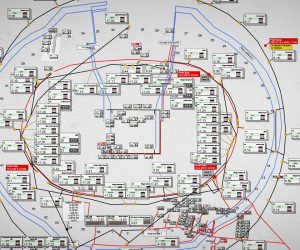
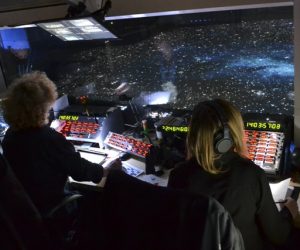



RESPONSES